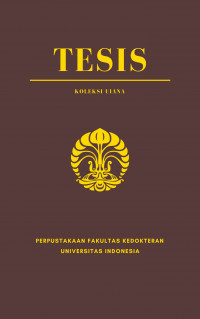Tesis
Kadar optimal hemoglobin dan hematokrit pada praoperasi reparasi Tetralogy of Fallot = Optimal preoperative level of hemoglobin and hematocrit in tetralogy of Fallot repair.
Latar belakang: Peningkatan pada hemoglobin (Hb) dan hematokrit (Ht) pada anak dengan penyakit jantung bawaan sianosis. Kondisi ini menyebabkan perubahan hemodinamik dan koagulasi yang dapat meningkatkan mortalitas dan morbiditas pasien. Operasi reparasi Tetralogy of Fallot (TOF) di Indonesia seringkali terlambat sehingga pasien menderita hipoksemia kronis. Penelitian ini bertujuan untuk mengetahui hubungan kadar Hb dan Ht pada luaran hasil operasi reparasi TOF serta mengetahui titik potong Hb dan Ht yang optimal untuk menghindari morbiditas dan mortalitas pascaoperasi. Metode: Dilakukan suatu studi retrospektif kohort pada pasien yang menjalani operasi reparasi TOF di Pusat Jantung Nasional Harapan Kita dalam periode 1 Januari 2015 hingga 30 Juni 2020. Analisis statistik dilakukan pada kadar Hb dan Ht praoperasi TOF dengan luaran mortalitas, kejadian perdarahan, transfusi darah, reoperasi, dan defisit neurologis pascaoperasi untuk menilai titik potong Hb dan Ht optimal serta pengaruh pada masing-masing luaran operasi tersebut. Hasil: Sebanyak 806 pasien dilibatkan sebagai sampel penelitian dengan median usia 53 bulan dan SpO2 80%. Terdapat pengaruh bermakna usia, berat badan, dan SpO2 terhadap Hb dan Ht (p < 0,05). Terjadinya peningkatan risiko perawatan > 72 jam sebesar 1,5 kali lipat pada Hb yang tinggi serta risiko sebesar 1,6 kali lipat pada Ht yang tinggi. Terdapat peningkatan risiko perdarahan pascaoperasi > 10mL/Kg sebesar 4,6 kali lipat pada Hb yang tinggi serta peningkatan risiko sebesar 5,4 kali lipat pada Ht yang tinggi. Tidak terdapat pengaruh bermakna Hb dan Ht terhadap kematian intraperawatan, kejadian reoperasi, dan defisit neurologis pascaoperasi. Diperoleh titik potong (nilai optimal) Hb 16,75 gr/dL dan Ht 51,20% dengan kemampuan prediktor yang cukup baik (AUC Hb = 0,71; AUC Ht = 0,72). Simpulan: Peningkatan hemoglobin dan hematokrit secara bermakna mempengaruhi durasi ICU, perdarahan pascaoperasi, dan banyaknya transfusi pascaoperasi. Untuk praoperasi TOF, diperoleh kadar optimal Hb di bawah 16,75gr/dL dan Ht di bawah 51,20%.
Kata kunci : Tetralogy of Fallot, hemoglobin, hematokrit, reparasi
Introduction: Increase of hemoglobin (Hb) and hematocrit (Ht) occurs in children with cyanotic heart disease. These conditions will lead some hemodynamic and coagulation changes that can increase patient mortality and morbidity. Tetralogy of Fallot (TOF) repair surgery in Indonesia mostly in late condition, where the patient suffers from chronic hypoxemia. Aim of this study are to determine the impact of high Hb and Ht on TOF repair surgery outcome as well as to determine the optimal value of Hb and Ht to avoid postoperative morbidity and mortality. Method: A retrospective cohort study was conducted on patients undergoing TOF repair surgery Pusat Jantung Nasional Harapan Kita from January 1, 2015 until June 30, 2020. Statistical analysis was carried out on the preoperative TOF Hb and Ht levels with mortality, bleeding incidence, blood transfusion, reoperation, and postoperative neurological deficits to find the optimal Hb and Ht cutoff point and the effect on each of these operative outcomes. Results: A total of 806 patients were included in the study sample with median age of 53 months and an SpO2 of 80%. There was a significant effect of age, body weight, and SpO2 on Hb and Ht (p < 0.05). There was an increased risk of treatment > 72 hours by 1.5 times for high Hb and a risk of 1.6 times for high Ht. There an increased risk of postoperative bleeding > 10mL / Kg by 4.6 times in high Hb and an increased risk of 5.4 times in high Ht. Transfusions > 15mL / Kg were found to increase by 1.5 times at high Hb levels and 1.7 times at high Ht levels. There was no significant effect of Hb and Ht on inhospital mortality, reoperative incidence, and postoperative neurological deficits. The cut points obtained in this study were Hb 16.75 gr / dL and Ht 51.20% with a fairly good predictor ability (AUC Hb = 0.71; AUC Ht = 0.72) on postoperative bleeding. Conclusion: High hemoglobin and hematocrit is significantly affected the ICU duration, postoperative bleeding, and the number of transfusions. The cut-off point taken from the relationship between hemoglobin and hematocrit on postoperative bleeding has a fairly good predictor ability. Optimal hemoglobin is below 16.75 gr/dL and optimal hematocrit is below 51.20%.
Keywords: tetralogy of Fallot, hemoglobin, hematocrit, repair
- Judul Seri
-
-
- Tahun Terbit
-
2020
- Pengarang
-
Gary Pradhana - Nama Orang
Oktavia Lulyasari - Nama Orang
Budi Rahmat - Nama Orang - No. Panggil
-
T20396fk
- Penerbit
- Jakarta : Program Studi Ilmu Bedah Toraks Kardiovaskular., 2020
- Deskripsi Fisik
-
xvi, 61 hlm. ; 21 x 30 cm
- Bahasa
-
Indonesia
- ISBN/ISSN
-
-
- Klasifikasi
-
NONE
- Edisi
-
-
- Subjek
- Info Detail Spesifik
-
Tanpa Hardcopy
| T20396fk | T20396fk | Perpustakaan FKUI | Tersedia |


Masuk ke area anggota untuk memberikan review tentang koleksi